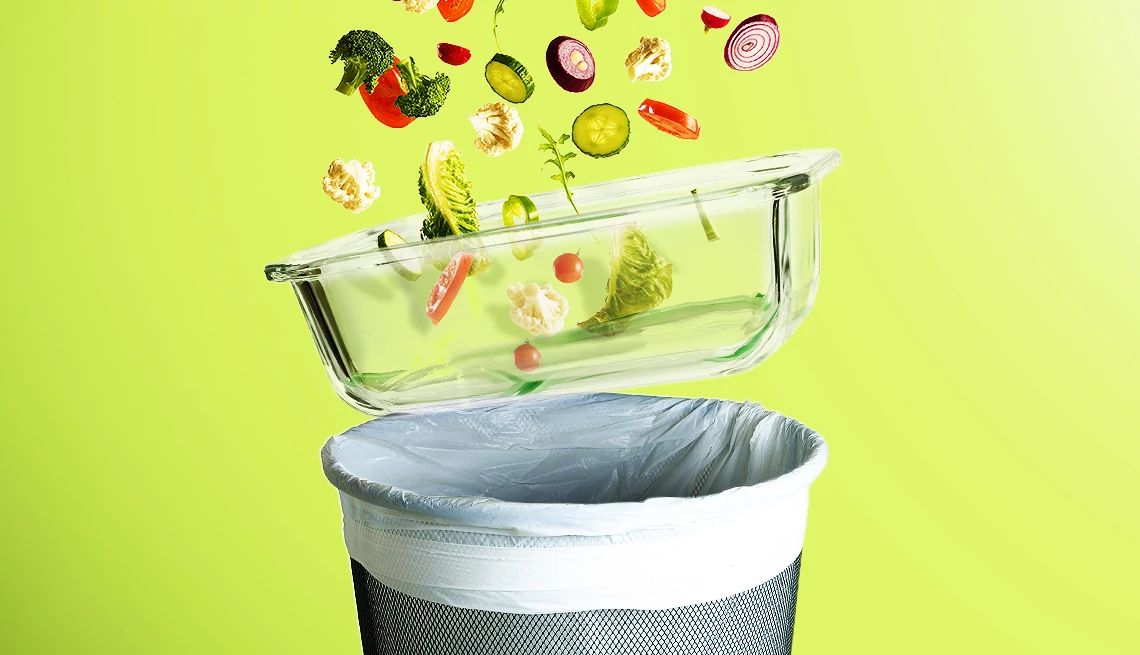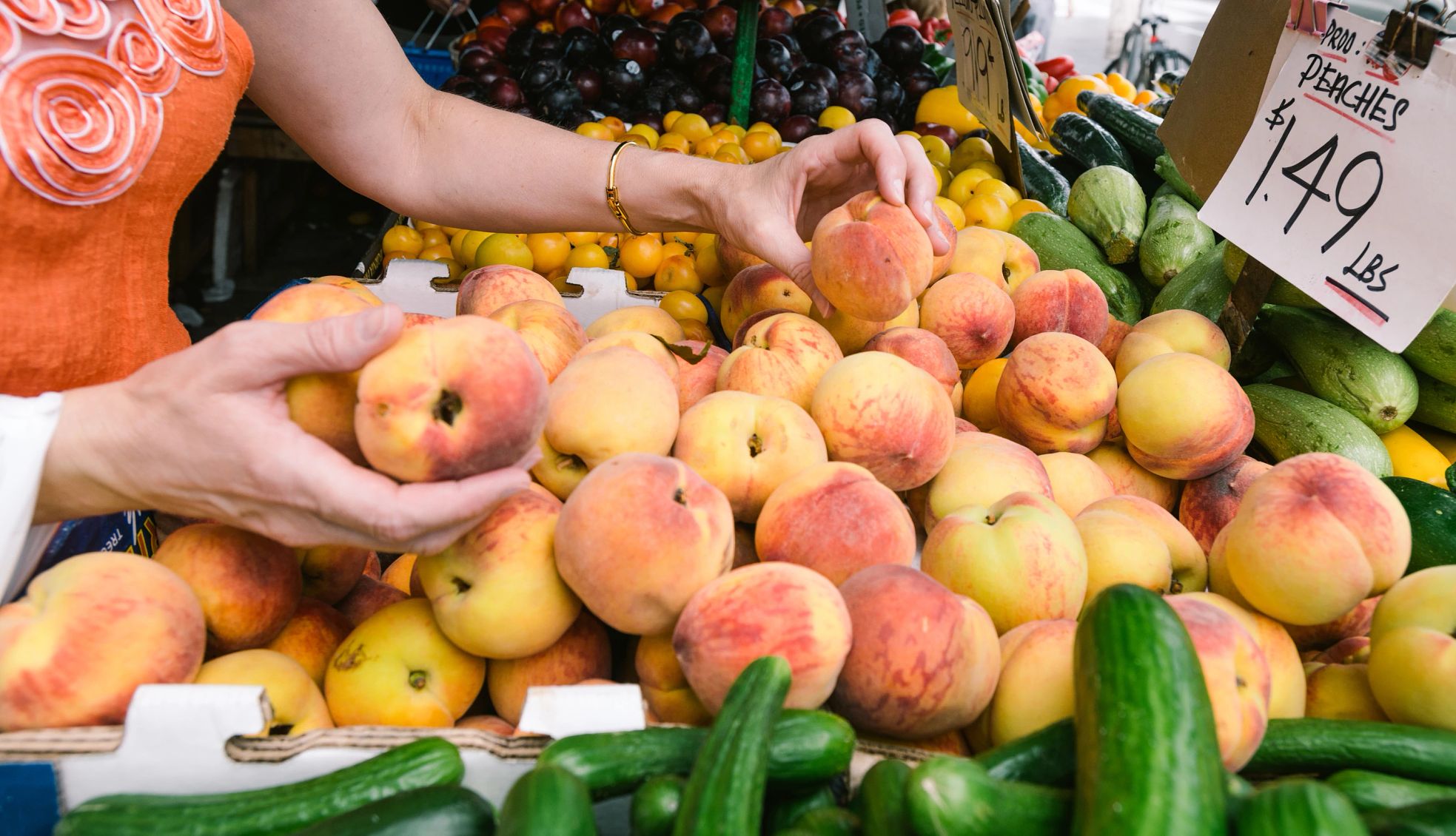AARP Hearing Center


In this story
Planning ahead • Fruits and vegetables • Storage and usage • Shelf-stable products • Frozen foods • Storage products • Food scraps • Composting
Americans throw out more than 400 pounds of food per person annually, according to research from the National Resources Defense Council (NRDC). For a household of four, that’s an average of $1,800 wasted each year. It’s a lot of food — and money — to toss away, especially for those over 50 who might be on a fixed income. Here are 49 tips on reducing food waste, a veritable grocery list of ways to save.


PLANNING AHEAD
1. Take stock of your inventory
Explore your refrigerator, freezer and pantry before making your grocery list. This will inform your shopping decisions and prevent overbuying. “Check not only which items you have, but how much you have left of remaining ingredients that you may be using such as flour, sugar, rice, etc.,” says Stephanie De La Hoz, program director with Move For Hunger, a nonprofit that collects and delivers surplus food to those in need.
2. Be realistic
How often do you plan to cook seven nights a week but only cook four or five nights instead? Something always comes up, like a hectic day that ends with convenient takeout or a lazy bowl of cereal. Changes to your cooking schedule contribute to waste, so plan for a few nights off each week.
3. Let the discounts guide you
Check your grocery store’s sales flyer, website or app to see if items you normally buy are on sale, suggests Mary Bryant Shrader, author of The Modern Pioneer Cookbook and creator and host of the Mary’s Nest YouTube channel. Add those products to your grocery list and build meals around them. Shrader also likes to maximize her shopping dollars by checking the clearance aisle for staples.
4. Lean into leftovers
If you make a meal you can’t finish before it goes bad, such as a big batch of homemade spaghetti sauce or chili, De La Hoz suggests packaging smaller portions and freezing them. “Or give some to neighbors and friends,” she says. “Soups can be easily frozen and warmed up when needed.”
5. Consult a portion calculator
Not a fan of leftovers? Calculate exactly how much food to serve so that everyone at the table is satisfied. Todd Lawrence, executive director of Urban Green Lab, a Nashville nonprofit that teaches communities how to live sustainably, suggests consulting the Guest-Imator. It’s an online meal-planning tool developed by SaveTheFood.com, a campaign from the NRDC. Select the number of people dining, answer a couple of questions about their eating habits, and it’ll determine the appropriate serving sizes for sides, the main dish and dessert, too. Additionally, apps such as Eat This Much and BigOven can help you plan meals and avoid food waste.
6. Grab from the back at the store
Most grocery stores restock shelves from the back, so items at the front are likely to expire sooner. If you don’t plan on using the item in the next few days, grab one from the back of the shelf.
7. Choose double-duty ingredients
Once you’ve mapped out your meals for the week, see what ingredients they share to create a more versatile shopping list. For instance, if you buy shredded cheese for a taco dinner on Monday, use it again to top loaded baked potatoes on Tuesday, then add it to an omelet over the weekend. (Omelets are also great for using up extra veggies and meats.)
8. Make substitutions
“If there are recipes that use ingredients you don’t use often, consider skipping the ingredient or swapping it for something you use more frequently,” De La Hoz says. She says some ingredients have easy substitutions, like parsley for cilantro or milk for heavy cream. If you do buy the special ingredient, look for ways to use it up beyond that one recipe.
9. Make a grocery list and stick to it
You’re less likely to stray from your intended purchases if you make a list. Use pen and paper (or an app like Mealime, Paprika or PlateJoy) to plan what you’ll cook each day of the week. “When making your list, record how much of an item you need, so you don’t accidentally purchase 40 ounces of cheese when you only need 16 ounces,” Lawrence says.
10. Resist temptation
Do you really need items that aren’t on your list? Think hard about impulse purchases, especially if you’re shopping hungry. “Challenge yourself to stick to your list to get the most out of the items you actually need,” De La Hoz says. Another trick? Avoid stores altogether and use grocery delivery services like Instacart, Hungryroot or Shipt instead.
11. Shop like Europeans do
Europeans tend to have smaller kitchens, pantries and refrigerators, so they typically only buy a few days’ worth of groceries at a time. Try to emulate this practice. “It’s better to buy fresh food every couple of days than stockpile your groceries in large quantities,” says Steven Satterfield, the James Beard Award–winning chef of Miller Union in Atlanta. His first cookbook, Root to Leaf, focuses on using all parts of a plant to reduce waste. “Purchasing food in smaller increments means less chance of waste and more awareness of what you have on hand.”


FRUITS AND VEGETABLES
12. Rinse all produce
Even if they claim to be “prewashed,” give your fruits and vegetables a thorough cleaning. De La Hoz suggests soaking them in a bowl with one part vinegar and two parts water for 5 to 10 minutes. “Not only does this remove pesticides and other chemicals, it also helps extend the freshness of the produce,” she says. For larger and firmer produce like apples, potatoes and zucchini, the U.S. Department of Agriculture (USDA) recommends washing under running tap water and scrubbing with a brush to remove any dirt. Never use detergent, soap or commercial produce washes — they aren’t recommended by the Food and Drug Administration, and you could end up ingesting their residue.
13. Dry all produce well
Extra moisture can make some produce rot faster, so Shrader says make sure you know which items can be stored with moisture and which cannot. “For example, carrots are best stored with the green tops removed and then wrapped in a damp towel and placed in an airtight container,” she says. “On the other hand, lettuce is best stored in an airtight container once completely dry and moisture free.” Air-dry produce on the counter on top of a cloth or paper towel before storing.
14. Test your berries
Flip over your berries’ container at the grocery store — if any stick to the bottom, they won’t last as long. “Choose berries that look bright and firm with minimal soft spots,” De La Hoz says. “Ensure that there are no signs of mold or liquid present in the container.”
15. Pick the ugly fruit
Nobody’s perfect, including fruits and veggies. “The demand for perfectly shaped and sized fruit and veggies leads to enormous waste in our food system,” says Jessica Josephine Synkoski, vice president of sustainability and corporate social responsibility for Sodexo North America, a food services and facilities management company. “There’s no difference in taste between a curved carrot and a straight one.” Services like Imperfect Foods, Hungry Harvest and Gotham Greens embrace imperfections by delivering groceries with cosmetic quirks right to your doorstep. It’s important to note that ugly doesn’t mean damaged — avoid produce with bruises or gashes, as those items may rot quickly.
16. Shop farmers markets early
If you go to a farmers market early, De La Hoz says you’ll have first pick of the produce. This allows you to select the freshest fruits and vegetables. That’s especially helpful on warm days, when the sun and heat could cause produce to wilt or spoil quicker. Synkoski says the farmers market is also an ideal place to pick up ugly fruits and veggies.
17. Separate certain fruits and veggies
Some fruits produce gases when they ripen. Keep them away from other fruits and veggies to minimize adverse reactions, including diminished quality and over-ripening. “Bananas are known to have this effect when placed next to other produce items, so consider storing them separately from other produce,” De La Hoz says.



































































You Might Also Like
Tips to Save at the Grocery Store
From getting creative to what food to avoid, here are ways to cut down on costs at the supermarket
9 Ways to Reduce Food Waste at Home
From growing your own food to using imperfect produce and labeling what to eat first, we have tips
‘Here We Go Again’ Cookbook
Actress Tiffani Thiessen transforms leftovers into family-favorite meals
Recommended for You